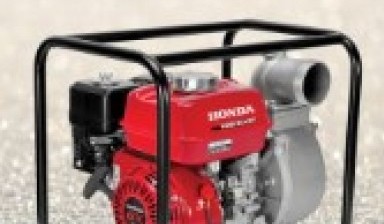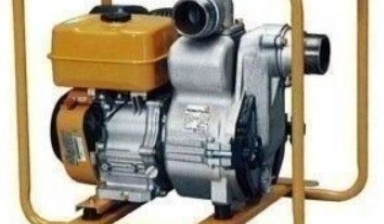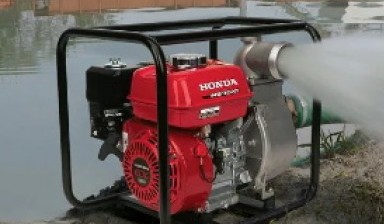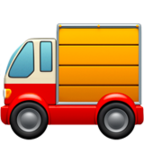- Home
- UAE
- Construction equipment rental
- Pumps and power pumps
Pumps and power pumps in the UAE
Search of pumps and power pumps in the UAE
A motor pump is a specialized device designed for pumping water and other liquids. It consists of an engine and a pump. The centrifugal pump operates as follows: inside a casing with two inlet and outlet ports, a fast-rotating impeller draws water through the inlet port and, due to centrifugal force, expels it through the outlet port. This creates a vacuum around the impeller, allowing a new batch of water to be sucked in. A "spiral" in the casing helps to form a directed flow. A drawback of this type of device is the need for initial filling.
In a diaphragm pump, a high pressure differential is created by the synchronous operation of a system of diaphragms and ball valves mounted in the casing, functioning similarly to a piston engine. The disadvantage of such units is the need for periodic replacement of diaphragms and valves.
General Advantages of Motor Pumps:
Autonomy
Mobility
Ease of operation
Disadvantages:
High noise level
Relatively low suction height
Not suitable for pumping very hot liquids (maximum temperature up to 90°C; parameters in instructions are given for water at 20°C).
Classification of Motor Pumps
- By Pump Type:
Centrifugal
Diaphragm
- By Engine Type:
Gasoline: This group includes relatively inexpensive household units with low power. Lifespan: up to 5,000 operating hours. Performance: up to 600 l/min. Advantages: compactness, ease of use (no special training required), low maintenance needs, no special storage conditions needed.
Diesel: Typically used for professional setups with powerful pumps and high operational lifespan. They have a higher torque compared to gasoline units and operate smoothly at various speeds, making them capable of pumping heavily contaminated water.
Electric: Less common. The main advantage is the ability to operate in places where the first two categories cannot, such as enclosed spaces.
Gas: Two types exist:
Cylinder-type (connected only to gas cylinders)
Universal (can operate from both cylinders and the main gas network)
Gas units are very economical but are not widely popular today.
- By Purpose:
For Clean or Slightly Contaminated Water: Designed for water with particles up to 6-7 mm in diameter. The impeller is often made of plastic. Household gasoline units with a performance of 150 to 350 l/min (9-21 m³/hour) are suitable for garden and agricultural plots.
For Dirty Water: The main difference is larger inlet openings. The impeller must be made of metal. These pumps can handle liquid with particles up to 20-30 mm in diameter. Performance starts at 750 l/min (45 m³/hour) and above, typically used by municipal enterprises.
For Pumping Sea (Saline) Water or Aggressive Liquids: The casing and working parts of these devices are made from materials resistant to harmful factors.
Fire Motor Pumps: Also used for pumping water during emergency flooding. They feature high pressure and performance up to 2,000 l/min (120 m³/hour) and above. They often have the letter "H" in their designation. No preliminary filling is required.
- By Engine Type:
Two-Stroke: More compact units with lower performance and pressure compared to four-stroke engines. Mainly used in garden plots. They require a mixture of gasoline and oil for fuel. They can pump liquid from small bodies of water or tanks, but units with larger diameter ports are not suitable for irrigation.
Four-Stroke: Larger units with higher working characteristics. Used for professional purposes in industry, construction, etc. In the private sector, they are used for water supply over long distances. They run on pure gasoline, and oil is added to the crankcase. New units require adherence to break-in conditions. Overhead valve engines are more durable than those with valves positioned below.
Main Operating Characteristics of Motor Pumps
- Performance (m³/hour): This depends on the lift height (head) and the diameter of the pipes, which is reflected in a special chart. In general, for pumping clean or slightly contaminated water for household needs (such as in garden plots, maintaining private pools, etc.), a unit with a performance of up to 600 l/min (up to 36 m³/hour) is sufficient. For construction sites or municipal services, for draining water from basements or ponds, it is better to choose a unit with a performance of 600-1000 l/min (36-60 m³/hour). If you need to work with large volumes of liquid, a motor pump capable of delivering up to 2000 l/min (120 m³/hour) or more will be required.
- Nominal Passage Diameter: Among the most common sizes are: 1” (approximately 25 mm), 2” (50 mm), 3” (75 mm), and 4” (100 mm).
- Head (m): In most cases, a large head is not necessary to pump water. A head of 25-35 meters is usually sufficient. Only fire pumps require about 50-60 m. If the pump operates as a remote water supply source, the calculation must be adjusted for head loss over distance, as approximately 1 meter of head is lost for every 10 meters of hose.
- Suction Depth: The maximum value for this indicator for motor pumps is between 7.0 and 8.5 meters. Therefore, the pump should be positioned as close to the water level as possible. If it is necessary to increase the suction depth for any reason, an ejector can be lowered into the water next to the hose. Most modern models are self-priming; to start them, you simply need to fill the pump casing with water, after which the unit will "draw" water through the empty hose for further operation.
- Head Loss During Pumping: This figure depends on the hydraulic resistance of the pipelines and fittings (connections, valves, etc.). Resistance will be lower for wider pipelines with smooth inner surfaces. For this reason (to reduce resistance), unnecessary valves and connectors that can be omitted should not be installed in the system. Roughly, hydraulic head losses can be estimated as follows:
Fully open valve – 1 m;
T-shaped connector – 3 m;
Connector with a 180-degree turn – 2.5 m;
90-degree turn – 2 m;
45-degree turn – 1.5 m.
Recommendations for Operating a Motor Pump:
Continuously monitor the engine's operation "by ear," checking for any unusual noises or knocks that are not characteristic of a normally operating motor.
Avoid using a heavily contaminated intake screen. To secure the vertical position, a weight can be attached to the end of the hose. The screen should not touch the bottom of the water body; the recommended distance from the intake should be at least 30 cm from the bottom or walls and 20 cm from the water surface. If the hose is too close to the water surface, air may enter the system, causing a hydraulic shock and subsequent damage to the impeller.
Periodically check the position of the suction hose, ensuring it is not bent. The suction hose should be corrugated for this purpose. The minimum bending radius of the hose should be double its outer diameter.
When installing hoses under clamps, avoid creating folds. The clamp should be tightened to less than 40% of the hose wall thickness. The distance between the edges of the hose and the clamp should exceed 4 mm.
The suction filter should be positioned vertically.
If liquid does not start flowing from the water body after the motor is started, the power unit must be shut down immediately.
After operation, clean the suction filter and the external surface of the hoses, and drain water from them.
Safety Precautions
Before the first start, inspect the unit, check the cleanliness of the intake screen, and ensure the reliability of the connections, especially the fuel line and both hoses.
The motor pump must be in a stable position.
Do not leave the device unattended while the engine is running.
When filling the engine and suction hose with water (if required), do not allow water to contact motor components, especially the spark plug.
Avoid allowing flammable fuels to come into contact with the muffler or engine cylinder.
When operating the motor pump, it is prohibited to:
Pump any solutions or contaminated water unless the unit is designed for it.
Refuel the tank with the engine running (this can only be done after the motor has stopped and the casing has cooled).
Operate the engine without water in the pump.
Use gasoline with an octane rating of "95" or higher.
Swap the suction and discharge hoses.
Start operation without a filter on the suction hose.
Operate with insufficient oil levels (for four-stroke engines).
Modify the fuel system design.
When starting the motor, do not wrap the starter cord around your hand, hold the unit by the frame with one hand and by the stand with your foot.
Touch the spark plug, muffler, high-voltage wire, or terminal.
Motor Pump Calculation Example
Suppose you need to organize the pumping of a water body to a specific location. The initial data are as follows:
From the pump installation point to the water body: 6 m
To the discharge point (water release from the hose): 20 m
From the pump to the water level: 3 m
Height of the discharge point: 2 m
Desired pressure at the hose outlet: 0.5 atm (approximately equal to 5 m of head)
Calculation Steps:
Total head (lifting height): 3 + 2 + 5 = 10 m
Head loss over length (10 m of hose = 1 m head): 2 m
Head loss on fittings: 1 + 2 = 3 m
Total head loss: 2 + 3 = 5 m
Total hose length: 6 + 20 + 5 = 31 m (where "5" represents total head loss)
Equivalent lifting height: 10 + 0.25 * 31 = 21.75 m ≈ 22 m
For the obtained head of 22 m, refer to the pump performance chart based on the lifting height and discharge diameter (in inches) to determine that for a diameter of 1”, the required performance should be 95 m³/hour.
Where to Rent a Motor Pump?
SpecGo allows direct interaction between construction equipment owners and clients, enabling the rental of motor pumps without intermediaries. You can request the service for water pump rental from any city in the UAE by simply submitting your request. Rental costs per shift or hour should be confirmed with the selected contractor based on the advertisement. Rentals are conducted by verified owners, ensuring quality work.


-
+97192222380 WhatsApp
| Equipment brand | Honda |
| Power | 3500 Wt. |
| Pump type | diesel |
| Purpose type | for clean water |
| Work experience | more than 10 years |
| Payment method | cash/cashless |
| Payment procedure | Payment by the fact |
 WhatsApp chat
WhatsApp chat


-
+9718088321887 WhatsApp
| Equipment brand | Fubag |
| Loading height | 17 m. |
| Pump type | diesel |
| Purpose type | for dirty water |
| Work experience | more than 10 years |
| Payment method | cash/cashless |
| Payment procedure | Payment by the fact |
 WhatsApp chat
WhatsApp chat


-
+971554725490 WhatsApp
| Equipment brand | Wacker |
| Loading height | 24 m. |
| Pump type | diesel |
| Purpose type | surface |
| Work experience | 5 years |
| Payment method | cashless payment |
| Payment procedure | Payment by the fact |
 WhatsApp chat
WhatsApp chat


-
+971556721522 WhatsApp
| Equipment brand | Honda |
| Loading height | 20 m. |
| Pump type | gasoline |
| Purpose type | for clean water |
| Work experience | more than 10 years |
| Payment method | cash/cashless |
| Payment procedure | Payment by the fact |
 WhatsApp chat
WhatsApp chat


